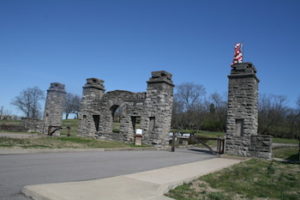
Front (2009)
Fort Negley, Nashville, TN, was completed on this date in 1862. This military facility was built during the American Civil War, mainly with Black labor supervised by the Union Army.
During the fall and winter of 1862, the Union Army built the fort to defend Nashville against Confederate Army attacks. On February 25, 1862, after the Confederate Army of Tennessee retreated from defeat at Fort Donelson, the Union Army occupied Nashville. In March 1862, President Abraham Lincoln appointed Senator Andrew Johnson as military governor. Because of his nervousness about Confederate attacks, Johnson begged federal officials to strengthen the town. General James S. Negley, the post commander, used the post's 6,000 soldiers and Black laborers to fortify Nashville, the capital.
Negley employed Captain James S. Morton, an army engineer, to design and build a fort to protect the south road and railroad approaches to Nashville. The Union Army recruited and forced nearly 2,000 Blacks (free and slave) into Fort Negley's labor battalions. "Known men of treason," including Belle Meade plantation's William G. Harding, were arrested and lost money, slaves, and supplies to support the project.
The Union cavalry surrounded Nashville's three Black churches, arrested strong Black men and women, and marched them to the St. Cloud Hill construction site with axes, picks, and spades in return for certificates of labor to be paid later. Before the project ended, the army owed Blacks and some "loyal slave owners" over $85,958 in wages. On November 5, the Confederate cavalry attempted to invade the city. The Black laborers asked for arms and were refused.
Blacks were allowed to form a symbolic defensive line with picks and axes. The federal military drove the Confederates off and inflicted 68 enemy casualties. The fight took place at the site of today's Cameron-Trimble neighborhood. Afterward, more federal troops arrived to garrison the town. They rebuilt bridges and searched the countryside for food and supplies. Black laborers cleared trees, blasted the solid rock, and dug underground storehouses. Expert slave stonemasons shaped the stone and laid thick masonry walls.
Black women washed clothes, cooked food, and hauled debris in wheelbarrows. The Union Army and the Black workers completed Fort Negley on December 7, 1862. Captain Morton said, "To the credit of the colored population be it said, they worked manfully and cheerfully, with hardly an exception, and yet layout upon the works at night under armed guard, without blankets and eating only army rations. They worked in squads military-like companies, each gang choosing their own officers; one was often amused to hear the Negro captains call out: 'You boys over there, let them picks fall easy, or they might hurt somebody." When working on such Union Army projects, hundreds of Black laborers died from exposure and accidents.
Fort Negley became the most prominent Union Fort west of Washington, D.C. The topmost structure consisted of 12-foot timbers, a fence to hold horses, and soldiers' quarters. Rounded wooden rifle towers sat on top of each corner of the enclosure. The artillery rested on carriages, and smooth plank flooring surrounded the outside of the enclosure. Three-foot ramparts (nine-foot-thick embankments of earth walled with stone) protected the flat artillery area. Morton placed the fort's entrance on the north side with a gentle slope overlooking the city two miles beyond.
The fort also had a sharp salient, a gateway, a timber guardhouse, and a loop-holed bomb shelter flanking the gate. Fort Negley, a multilateral copy of an old Spanish design, used 62,500 cubic feet of stone and 18,000 cubic yards of dirt; occupied 600 by 300 feet and 51 acres of St. Cloud Hill; and rested some 620 feet above sea level.
The Union Army abandoned Fort Negley soon after 1867. The local Ku Klux Klan held secret meetings in the fort's blockhouses until 1869. During the early 1900s, Nashville's Black Republican Party leaders unsuccessfully petitioned Republican presidents to restore the fort. In 1937, the Federal Works Progress Administration restored Fort Negley. The fort, however, was allowed to fall into ruins again until the 1964 Civil War Centennial Celebration. 1975, Fort Negley was listed on the National Register of Historic Places.
In 1980, the Metro Historical Commission and an MHC plaque marked the entrance to the site. Years later, the Tennessee Historical Commission placed a plaque to note Blacks' involvement in the Civil War and the construction of Fort Negley. In 1994, the City Council approved $500,000 to begin the restoration of Fort Negley as a historical, tourist, and community resource. As late as 2000, Nashville had begun appropriating 3 million dollars for the project.
Battle of Nashville Preservation Society
(615) 780-3636